Fusion of Tradition and New project!
The Splendid Dancing with fertile plots, The Gion Odori
Last month, four flower towns were full of people viewing the autumn dance festival. In the winter season to be here before long, there is no big dance presentation but when the New Year has come and there will be the spring dance festival around March. Starting with the Kitano Odori, there are the Miyako Odori,the Kyo Odori and the Kamogawa Odori held successively.
And in June, there is “the Miyako no Nigiwai” (“The Prosperity of a City”).At the event, geiko and maiko of the five hanamachis get together and show splendid dance performances.
How we long for that early spring to come! But there is another performance that we should never forget for this autumn in fact. Those of you who visited Kyoto in early November might have seen a large crowd in front of the Gion-kaikan Theater near the Yasaka Shrine.Yes, it is the Gion Odori (the Gion Dance Festival). It is a presentation of performing arts by geiko and maiko of Gionhigashi. In contrast to the other four towns show theirs in spring, only this town has a custom to take place in autumn.
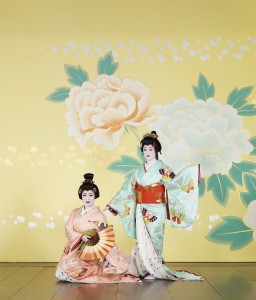
Geiko, Masayo san(left) and Miharu san at the 1st scene “A dance together by butterfly and fan”
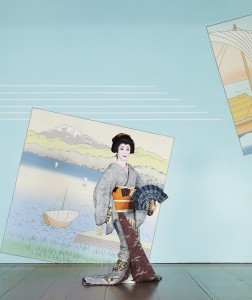
Geiko, Tsunekazu san at the 2nd scene“A tour round the main sights in Shikoku”
Originally, the Gion-kaikan Theater was used as a movie theater, it gained a reputation for its classic and nostalgic style. It was such a rare place where you could enter or exit freely, enjoy two films a day for a ticket and are allowed to bring in all sorts of food and drinks. In here, you could enjoy the Showa amusement which hardly exists today.
Maybe it is a natural occurring with the contemporary trend…regretfully, they finished showing movies on 30th of March this year. Today it is mainly used as a performing place for comedians except for a period of the Gion Odori. (now it’s called the Yoshimoto Gion Kagetsu.
It is the 55th time for the festival this year. It gets popular year by year for its unique structure. They graft a traditional mai(dancing) of The Fujima School, that is the second largest Schools in Classical Japanese Dances, to new project.
The theme for this year is called “Zanitawamuru-Yukyokunokuwasai.” There are five programs separately. In the first three, they first introduce ‘ozashiki play’including ‘Tosenkyo’or ‘Toratora’ and subsequently a dance performance which have some connection to the play is shown.
Suppose there are geiko and maiko perform a customer part and a geiko part. They show ‘Konpirafunefune’ (a representative ozashiki play) and after that, another geiko appears on stage, shows a dance related to the play.
Overpoweringly, a dazzling and stunning performance is shown at the event. Highlight of the event is not only a brilliant dancing, but also the fertile plots with an ingenious device.

Geiko,Tuneari san(left) and Masami san
You’ll be overwhelmed by their dignity-the geiko of Gionhigashi. There is Tuneari san, a well-known lady for her extraordinary beauty and Masami san who performed a man’s part in a splendid manner, etc. There was a coexistence of the two-a beautiful spirit that might make you speechless and generosity with kindness. The spirited maikos appeared and gathered on a stage altogether. There were Kanoka san, Kanoyumi san, Ryoka san, Kanoemi san, Tomitae san and Fukuharu san. It looked as if the maple leaves turning shining crimson.
It was so fascinating but the clock beats the minutes away. It was the fifth stage in an instant. At the finale,‘Gionhigashi Kouta’ was performed by all geiko and maiko of Gionhigashi. This a Japanese ballad accompanied on the musical instruments, which lyrics show changing of season in town. After 10-day period of performance, the festival came to an end at a great success.
A Little Story Part1 Legend of a flower town,Gion-higashi !?
There is a shrine called Kanki Inari Jinjya in Gionhigashi. It is a local tutelary deity and commonly known as ‘Kanki san’ since old times. Its appearance is in a silent manner so that you might miss it if you are walking with an abstracted air.
But amazingly enough, the shrine was first built in 1718. It is said that a site formally was the premises owned by Zezehan, (Zeze Domain) a feudal domain existed around Otsu in Omi Province. Their duty was to watch for a fire in Gosho, an Imperial palace. It seems that the separated spirit was enshrined when Akihagongen (a god of miraculous efficacy in fire prevention) was transferred to Chausuyama in Shiga prefecture. From that time on, the shrine is venerated as a god of disaster prevention, guard and prosperity.
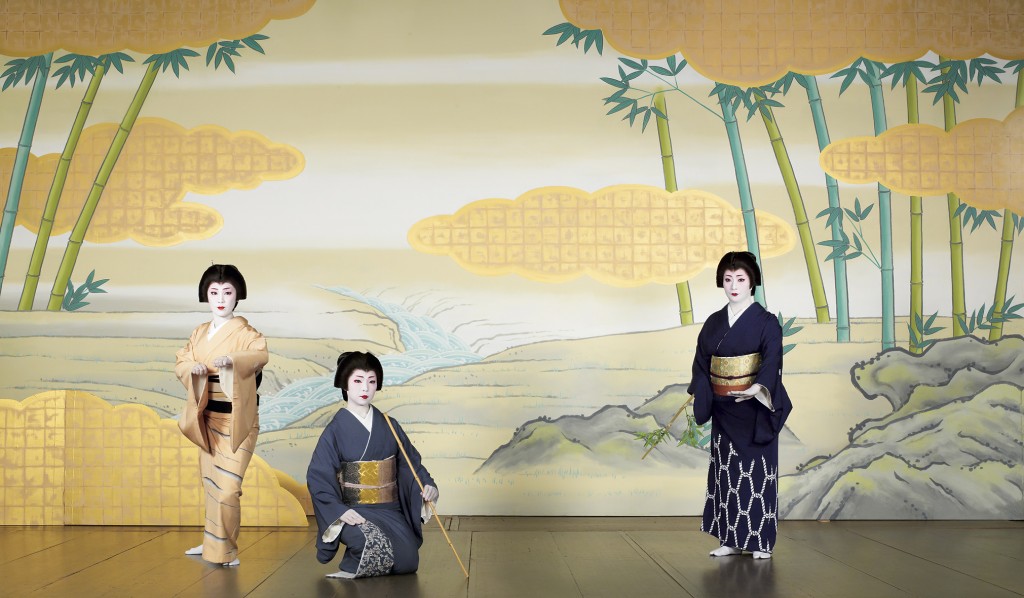
Geiko Mariko san(left),Hinagiku san and Tsunemomo san at the 3rd scene“Senri ga Takenoyu”
Is it because of divine virtues or not? Well, we are not sure, but strangely enough, the town of Gionhigashi had been delivered from a danger while the other flower towns all suffered fires several times in history.
The Big Torii (a gateway at the entrance of shrine) was rebuilt two years ago, there are various festivals including the Taisai (the Big Festival), the Ninoumasai and the Ohitakisai at Kanki san. Together with local people, geiko and maiko of Gionhigashi all gather to worship and pray at shrine. May they live in peace and quiet and bless with further prosperity and growth!
A Little Story Part2 Mystery of Japanese writings,“Odori”or “Wodori”?
Hiragana is the Japanese cursive syllabary. We mix hiragana with katakana and kanji (the Chinese character) to speak and write. There are unlimited numbers of combination, .and some tricky things about hiragana exist. There are two types of kana orthography-the old and the new.
Earlier in this issue, when I talked about the Gion Dance Festival, it was written as ‘the Gion Odori’. But to be precise, it should be ‘the Gion Wodori’. The former is the new and the latter is the old version. They both have the same meaning and pronounced in the same way, but when it comes to write in roman letters, it seems a little unfamiliar, so that I chose to write in the new version.
Don’t you wonder a reason for this troublesome rule? Well, though there are various theories about it, one theory holds that they kept the old kana orthography as a name for some reason. They wanted to succeed a dancing culture of hanamachi and inherit a long tradition simultaneously. So they kept the old one to regard with feelings of respect and reverence.
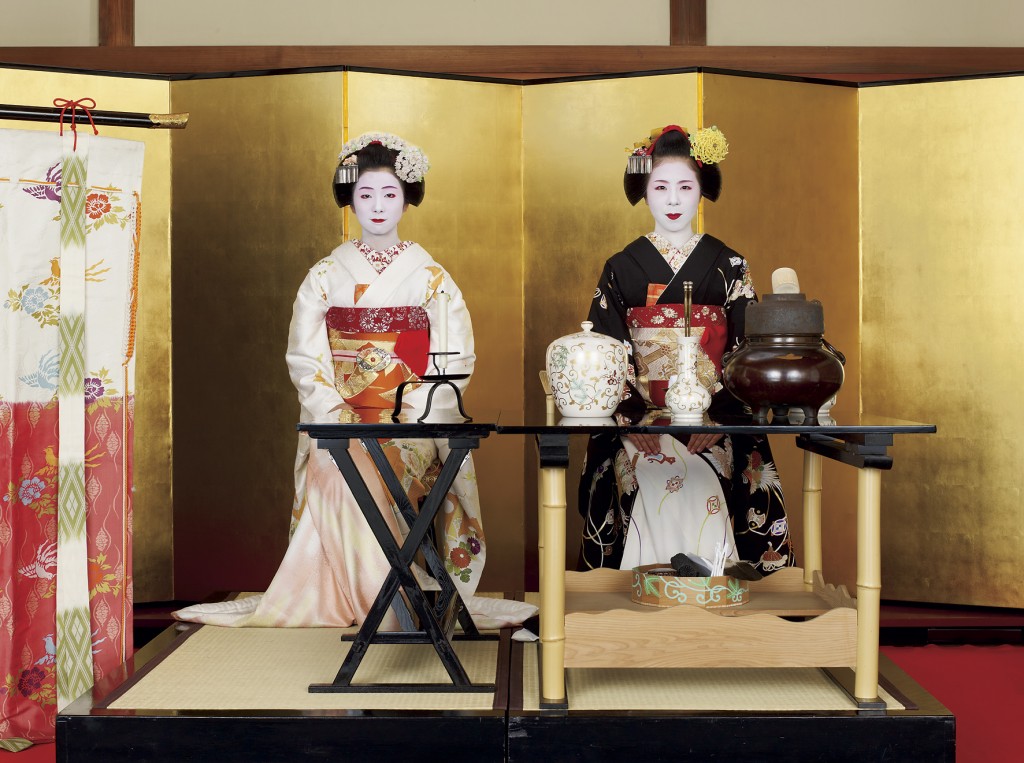
Maiko, Kanoemi san and Ryoka san at tea ceremony of the dance festival
There are three other dance festivals that use ‘Wodori’writing. That is the Miyako Festival of Gion-Kobu, the Kitano Festival of Kamishichiken and the Kamogawa Festival of Ponto-cho. The only flower town using the new transcription is the Miyako festival of Miyagawa-cho.
The reason is said to be related to the fact that a town had been prospered with a strong support of plays and theaters. They all grew together. Needless to say, the town keeps and inherits tradition like other towns, but according to one theory, they decided to write in a new orthography because they want to be more familiar with a flower town of Miyagawaho-cho.
Photos courtesy of the Gionhigashi Kabukai
Maiko’s Kanzashi in November
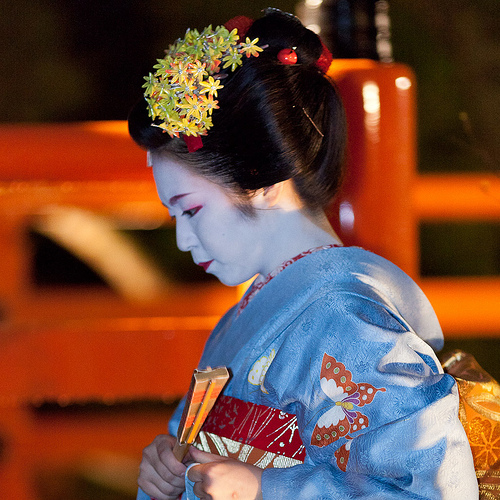
It is convincing that a woman with a fine profile is said to be the real beauty…
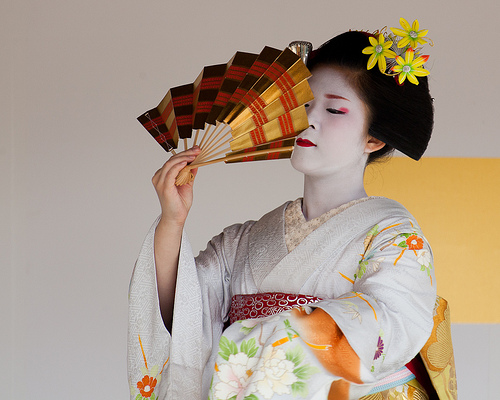
Maiko,Satohana san of Kamishichiken. She is the autumn luster!
Though maiko’s kanzashi normally have flower motifs, they wear the one with maple leaves decorated in November.
This is Ichitomo san on the left. Small leaves in golden color look like a star-dust inlay in the sky. It charms her jet-black hair still more. Originally, it is said that kanzashi derive from kamizashi (it literally means an ornament to insert into hair), but there is a mysterious presence that makes you think it is a part of herself in the picture. How do you feel?
On the other hand, Satohana san’s kanzashi is decorated with three large maple leaves. The yellow color stands out with a pale purple-themed kimono. Orange added on the edge of leaves set off as well.
Though it was purely accidental, whitish lemon color on the background, golden color of mai-ogi (a fan used for Japanese dancing) and darari-no-obi…everything set in the photo looks as if it creates a gorgeous autumn of Japan. The time leaves turn is known as a season of ‘Koyo.’ It is something peculiar to the country. You can find many colors in kimono and other ornaments. There is a way to enjoy like this when you look at maiko’s appearance.
Highlight Events in Kyoto,November
|
●The 15th The Ryomasai at Kyotoreizan Gokoku-jinjya Shrine |
|
●The 23rd The Momiji Matsuri(The Maple Festival)at Jinushi-jinjya Shrine |
|
●The 24th-26th The Kenkasai at Heian-jingu Shrine |
|
●The 26th The Minamiza Nemakiage at Minami-za Theater |
|
●The 26th The Ochatsubohokensai at Kitano Tenman-gu Shrine |
Photos:Copyright(c)2012 Geisha Japan All Rights Reserved
Special Thanks to: WALKKYOTO(some images on this article are provided by http://walkkyoto.exblog.jp/i30/ )



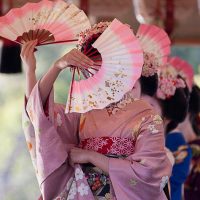
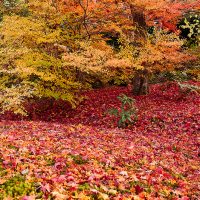
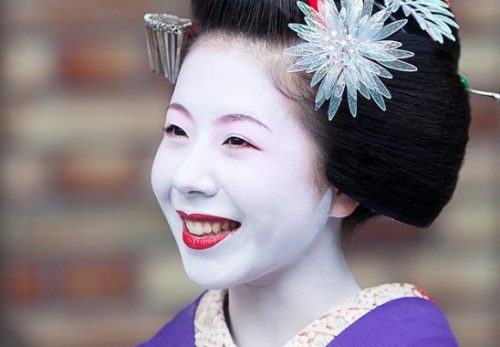
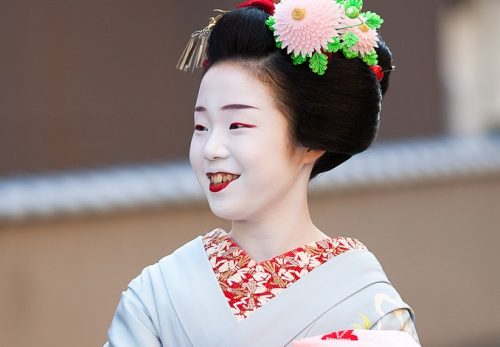

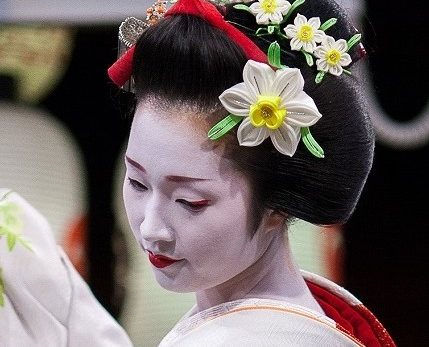
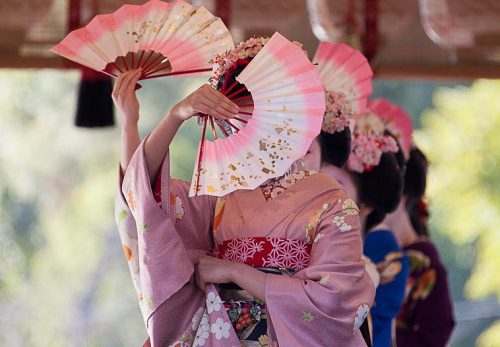
この記事へのコメントはありません。